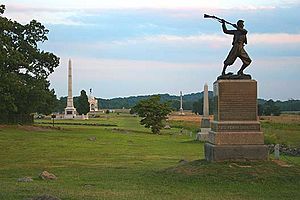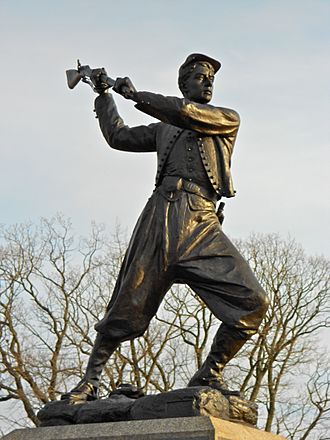72nd Pennsylvania Infantry Monument facts for kids
 |
|
| Coordinates | 39°48′46.8″N 77°14′10.6″W / 39.813000°N 77.236278°W |
|---|---|
| Location | Gettysburg National Military Park, Pennsylvania |
The 72nd Pennsylvania Infantry Monument is a special statue built in 1891 on the Gettysburg Battlefield. It stands on Cemetery Ridge, near a spot called The Angle and a group of trees. This is where Union soldiers, including the 72nd Pennsylvania Infantry, stopped Confederate forces during a big attack called Pickett's Charge.
This monument was part of an important legal case in the Pennsylvania Supreme Court. The case was about who had the right to decide where monuments could be placed on the battlefield. The monument is also shown on the 2011 "Gettysburg" America the Beautiful quarter coin.
The soldiers of the 72nd Regiment actually put up an earlier monument in 1883. To avoid confusion, that first monument is now often called the "Philadelphia Brigade" Monument.
Contents
Why Was the 72nd Pennsylvania Infantry Important?
The 72nd Regiment Pennsylvania Volunteers was a group of soldiers led by Colonel DeWitt Clinton Baxter. They were also known as "Baxter's Philadelphia Fire Zouaves." Many of them were firemen from Philadelphia. Their fancy uniforms looked like those worn by the Zouaves, a brave group from North Africa.
The 72nd Regiment played a very important part in stopping Pickett's Charge on July 3, 1863. When the Confederate soldiers started their attack, the 72nd was waiting behind the main cannons.
As the enemy came closer, the 72nd was quickly sent to the front line. They met the attackers at the famous stone wall and the clump of trees. That morning, the 72nd Regiment had 458 officers and men. After the fierce fighting, only 266 of them were left to continue the battle.
How Were Monuments Placed at Gettysburg?
In 1864, a group called the Gettysburg Battlefield Memorial Association (GBMA) was created. Their job was to protect the battlefield and approve all the memorial statues. The GBMA believed they had the only say in where monuments could go, even on land they didn't own.
In 1883, the GBMA approved the first monument for the 72nd Pennsylvania Infantry. They placed it where the regiment had suffered many losses. However, the soldiers of the 72nd Regiment strongly disagreed with this location.
Why Was the Location a Problem?
The GBMA chose a spot nearly 70 yards (about 64 meters) behind the main Union front line. The soldiers of the 72nd Regiment felt their monument should be right at the front line, where they had fought hardest.
Much of the battlefield was still privately owned. So, the 72nd Regiment bought their own small piece of land, about 900 square feet (84 square meters), right on the Union front line. They wanted to build a second monument there. They also got approval for this second monument from a different Pennsylvania state group, not the GBMA.
The Legal Battle Over the Monument
In July 1888, the GBMA said no to the 72nd Regiment building their second monument, even though it was on the regiment's own land. On December 12, 1888, the GBMA even had Captain John Reed, a member of the 72nd, arrested. He was arrested for trespassing because he had started building the foundation for the second monument.
What Happened in Court?
In October 1889, a court case began: Gettysburg Battlefield Memorial Association v. Seventy-second Pennsylvania Regiment. The case was about where the 72nd Regiment had fought during Pickett's Charge.
The Pennsylvania Supreme Court decided in favor of the 72nd Regiment. The court ruled that a state commission had the right to decide where monuments for Pennsylvania regiments should go. This meant the GBMA's rules didn't apply to Pennsylvania units. Justice Sterrett said that the state had the right to choose the spot where any of its regiments had shown great bravery.
The local newspaper, The Star and Sentinel, was not happy with this decision. They said it was unfair because other states' units still had to follow the GBMA's rules, but Pennsylvania units did not.
The Second Monument is Built
The monument is about 13.5 feet (4.1 meters) tall. It has a polished granite base and is topped with a life-sized bronze statue. The statue shows a "Fire Zouave" soldier fighting closely with the enemy, swinging his rifle like a club.
Captain John Reed, the veteran who was arrested, designed the monument. The sculptor's last name was Stephens. The statue was made by the Bureau Brothers Foundry in Philadelphia.
About 1,000 people came to the monument's dedication on July 4, 1891. Edward McPherson accepted the monument on behalf of the GBMA. However, the GBMA later had second thoughts. On August 25, they suggested putting a sign near the monument to say they were "not responsible for the location."
Protecting the Battlefield Land
The fact that the 72nd Regiment owned their monument's land was very important. It stopped the Gettysburg Electric Railway from building a tourist trolley track right across the field where Pickett's Charge happened. The 72nd Regiment refused to let the trolley company use their land. This forced the trolley to find another path, behind the Union lines.
To show that their land was still private, in June 1893, the 72nd Regiment marked the boundaries with stone markers. They also put up a "no trespassing" sign and a flagpole with the American flag (with 44 stars). The regiment's association owned this land until March 20, 1911. Then, they gave the land to the War Department.
The Monument on a Coin
The 2011 "Gettysburg" America the Beautiful Quarter coin was designed with help from people at Gettysburg National Military Park. The back of the coin shows an image of the 72nd Regiment's monument. The Codori Barn, which can be seen in the background of the coin's image, was actually built in 1882, after the battle.
On June 25, 2013, strong winds blew the 1,500-pound (680 kg) Fire Zouave statue off its base. This happened just one week before the 150th anniversary of the Battle of Gettysburg. Park workers lifted the slightly damaged statue back onto its base the next day. It was fully repaired over the winter.
Images for kids



